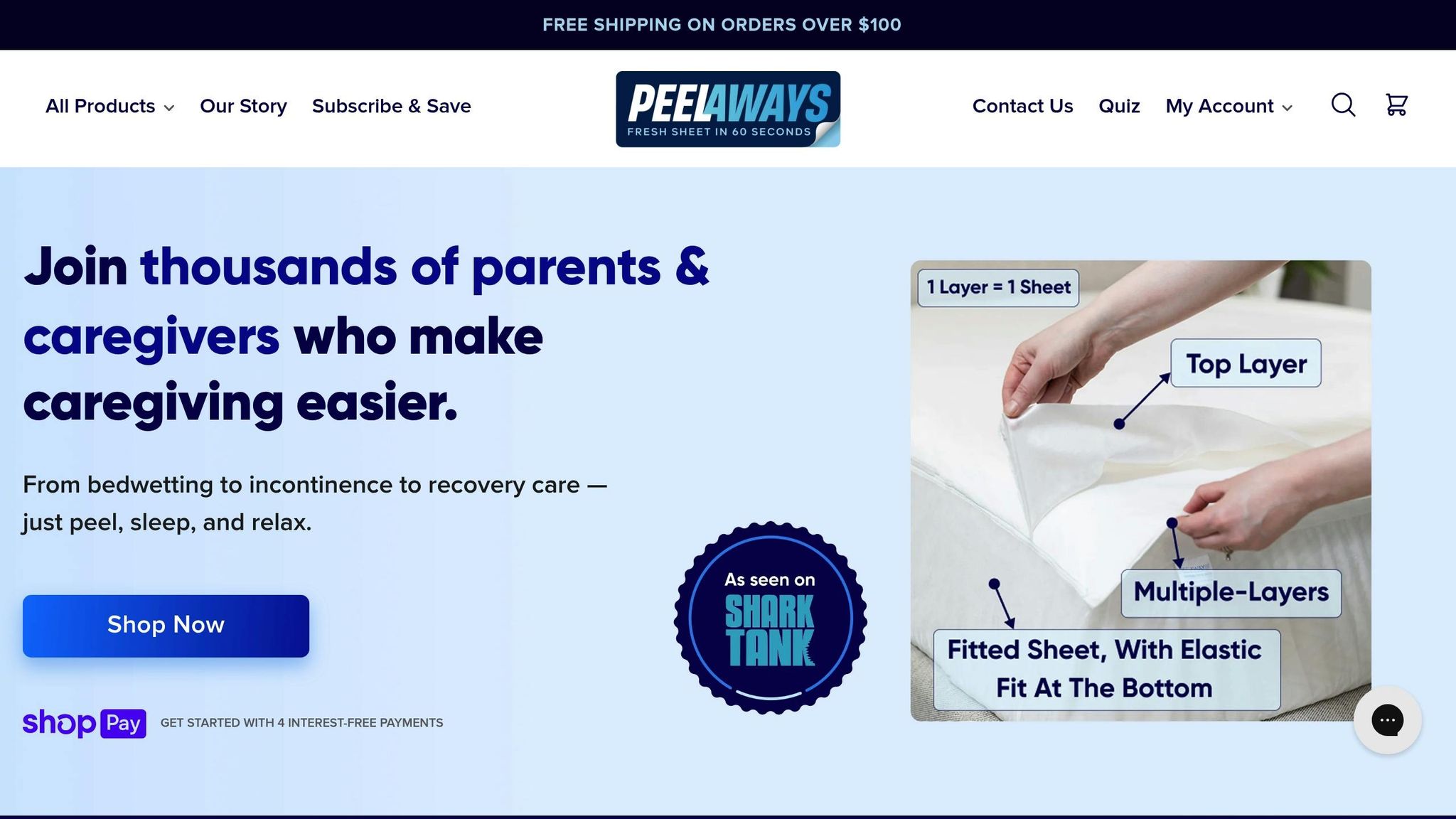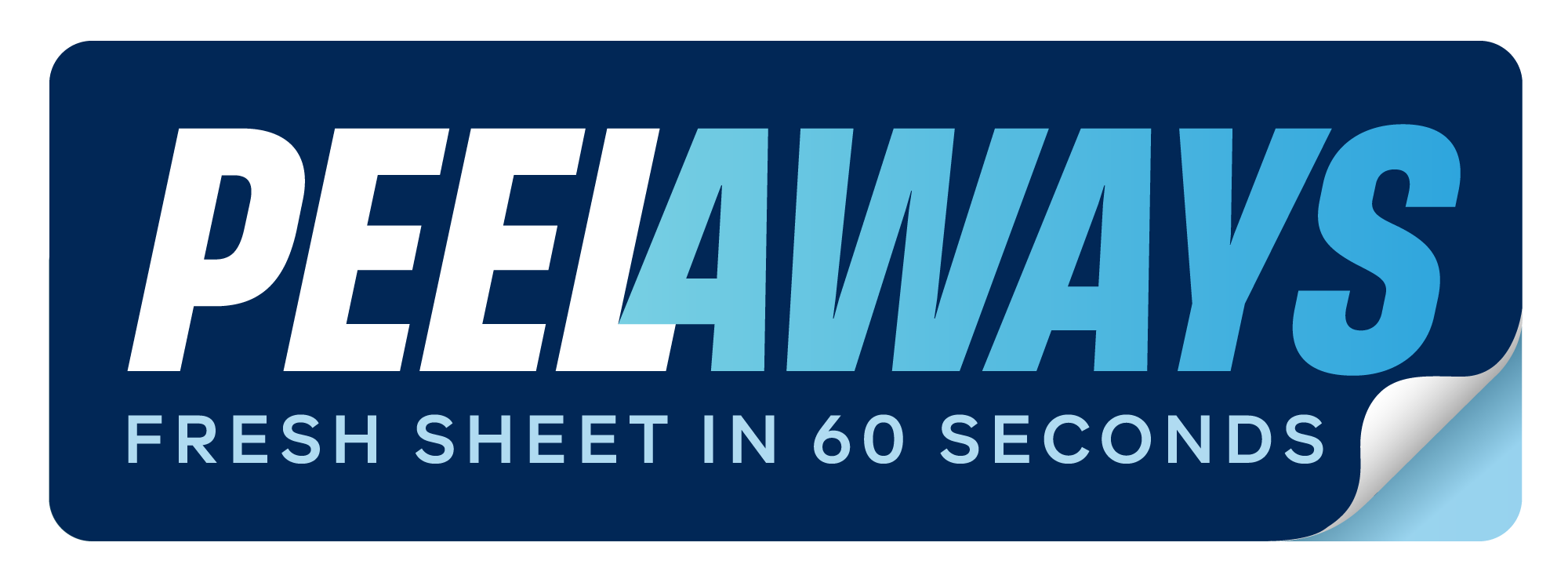Caregiver Stress and Communication Solutions

Caregiving is hard, but poor communication can make it even harder. Misunderstandings with doctors, unclear family roles, or feeling overwhelmed by medical jargon can increase stress and affect the quality of care. This article explores practical ways to improve communication, reduce stress, and enhance caregiving experiences. Key takeaways include:
- Listening actively: Pay attention to emotions and nonverbal cues to build trust.
- Clear communication: Use “I” statements, ask open-ended questions, and confirm understanding.
- Working with doctors: Request simple explanations, repeat back instructions, and use patient portals for updates.
- Family teamwork: Assign tasks based on strengths, use shared calendars, and hold regular check-ins.
- Support tools: Apps like CareZone and products like PeelAways sheets can simplify caregiving tasks.
Make Your Voice Heard: Tips for Effective Caregiver Communication
How Poor Communication Makes Caregiving More Stressful
When communication breaks down in caregiving, the consequences go far beyond minor inconveniences. It creates stress, uncertainty, and complications that ripple through care routines. Without clear and open exchanges between caregivers, healthcare providers, and family members, misunderstandings can lead to heightened anxiety and even impact the quality of care.
When Unclear Information Leads to Anxiety and Confusion
Imagine trying to navigate a complex medical situation with only half the information you need. That’s the reality for many caregivers when doctors use medical jargon or fail to explain test results and treatment plans in plain terms. This lack of clarity leaves caregivers second-guessing themselves, unsure if they’re making the right decisions. The constant worry about "getting it right" can be emotionally draining.
Adding to the stress, caregivers often have to repeatedly ask for clarifications. But with rushed appointments and limited time for follow-up questions, they’re left juggling an overwhelming amount of information. It’s easy to see how this can lead to information overload - a state where it feels impossible to process or prioritize what’s most important.
Within families, unclear role assignments can create even more tension. When caregiving responsibilities aren’t openly discussed, one person may end up shouldering the bulk of the work while others remain uncertain about how to contribute. This lack of coordination can leave caregivers frustrated and overburdened, draining the energy they need for the actual care tasks.
Time pressures make things worse. Important conversations often happen hurriedly over the phone or during chaotic moments, like while helping a patient get dressed or take medication. These rushed exchanges increase the risk of misunderstandings, leaving critical details overlooked. Ultimately, these communication gaps fuel worry and set the stage for broader challenges that affect both caregivers and patients.
The Ripple Effects on Patient Care and Caregiver Well-Being
When communication falters, it creates a cycle that harms both the patient and the caregiver. Misunderstandings between caregivers and patients can lead to missed health issues or inadequate responses to concerns, leaving caregivers questioning whether they’re meeting the patient’s needs. This uncertainty only adds to the emotional weight they carry.
The stress of poor communication doesn’t just stay in the mind - it impacts the body too. Caregivers often experience heightened anxiety, emotional exhaustion, and even depression when they lack clear information and support. Physically, the constant worry can lead to sleep deprivation, fatigue, and a weakened immune system, making it harder for caregivers to stay healthy themselves.
Overwhelmed caregivers may also find it harder to communicate effectively. When stress levels are high, listening, processing information, and expressing thoughts clearly become more challenging. This can lead to irritability or impatience, which only deepens misunderstandings. As a result, caregivers may struggle to fully understand a patient’s needs or preferences, complicating efforts to provide tailored care.
To make matters worse, when healthcare providers overlook the emotional toll caregiving takes, caregivers may feel dismissed or unsupported. This lack of acknowledgment can discourage them from asking questions or voicing concerns, creating a vicious cycle of miscommunication and stress. Breaking this cycle is essential - not just for the caregivers’ well-being, but for ensuring the best possible outcomes for patients as well.
Common Communication Problems Caregivers Face
Caregivers often encounter challenges that make effective communication difficult, and these struggles can escalate if left unchecked. Understanding these common barriers is a crucial step toward resolving them. Below, we explore the key obstacles caregivers face when trying to communicate effectively in care settings.
Time Constraints and Scheduling Conflicts
Packed schedules can leave caregivers juggling appointments, coordinating healthcare, and managing daily tasks, often at the expense of meaningful conversations. For instance, during medical visits, the limited time available may prevent caregivers from asking detailed questions or fully grasping complex treatment plans. Similarly, family discussions about care responsibilities or changes in a patient’s condition often occur on the fly - whether while administering medications, preparing meals, or rushing through hospital corridors. These rushed exchanges can lead to misunderstandings or overlooked details. On top of that, coordinating with family members in different time zones or with conflicting work hours can delay critical conversations, allowing minor issues to snowball into major ones.
Overwhelming Medical Jargon and Information Overload
Healthcare providers often use technical language that can confuse caregivers [5][9]. Add to that the sheer volume of information caregivers are expected to absorb - especially during moments like hospital discharges or specialist consultations - and it’s no wonder misunderstandings happen. When instructions are delivered in complex terms, caregivers may struggle to relay them accurately or feel too intimidated to ask for clarification. Even discharge papers, often written in dense, formal language, can discourage caregivers from seeking the answers they need, leaving critical care instructions unclear and increasing the risk of errors.
Emotional Stress as a Communication Barrier
Emotional stress is another major hurdle that can cloud communication [4][6]. When caregivers are overwhelmed by worry over a loved one’s prognosis or frustrated with the healthcare system, it can affect their ability to listen carefully, process information, or articulate their concerns. Fear, for example, might prevent them from asking tough but necessary questions about issues like end-of-life care or potential treatment side effects. This hesitation can leave them unprepared when quick decisions are required.
Frustration can also lead to defensive or overly emotional responses during conversations, making it harder for healthcare providers or family members to address practical matters. Isolation compounds the problem, as caregivers who feel alone in their responsibilities are less likely to seek help or share their concerns [4]. This combination of stress, isolation, and mental fatigue can leave important issues unresolved, further increasing the caregiver's burden and emotional strain.
Communication Methods That Reduce Caregiver Stress
Caregiving comes with its unique set of challenges, but using the right communication techniques can make a world of difference. These methods not only make conversations smoother but also help ease the stress that often comes with misunderstandings and unmet expectations. Let’s look at some effective ways caregivers can communicate to reduce their stress.
Listening Carefully and Showing Understanding
Listening isn’t just about hearing words - it's about being fully present. This means setting distractions aside, maintaining eye contact, and using body language that shows you’re engaged. Pausing to let the other person speak and validating their feelings with responses like, “That sounds tough,” can go a long way in building trust and understanding [1][5]. Instead of rushing to offer solutions, acknowledge their emotions with phrases like, “I can see why you’d feel that way.”
Nonverbal cues also play a huge role. Changes in tone, posture, or facial expressions can reveal discomfort or worry that words may not express. For instance, one caregiver noticed her mother moving cautiously and gently asked, “I see you’re moving more carefully today. Is something feeling tight or sore?” This led to a conversation about pain her mother hadn’t mentioned, improving both care and peace of mind [1].
Active listening strengthens the bond between caregivers and care recipients. It encourages openness, which is linked to better health outcomes, improved medication adherence, and higher satisfaction with care [1].
Using Clear Communication Steps
Clear communication can prevent misunderstandings and reduce stress. One effective approach is using “I” statements, like, “I feel overwhelmed managing all the tasks alone,” instead of blaming or accusing [3]. Being specific about what you need makes it easier for others to understand and respond. For example, instead of vaguely saying, “I’m stressed,” try, “I’m feeling drained because I’ve been handling all the medication schedules, and I’m worried I might make a mistake.”
Open-ended questions are another powerful tool. They encourage detailed responses and uncover information that simple yes/no questions might miss. For example, instead of asking, “Did you sleep well?” try, “Can you tell me about how you slept last night?” This could reveal issues like pain or anxiety that might be affecting their rest.
A pilot study showed that caregivers who received communication training felt more confident in their roles, with scores improving from 74.1 to 79.6 (p=0.03). This training also reduced confusion about care plans, minimized errors, and eased caregiver burden [10].
Learning to Express Your Needs Clearly
Caregivers often put others first, but expressing your own needs is just as important. Instead of making demands, frame your requests around your feelings. For instance, instead of saying, “You need to visit more often,” try, “I need help with meal preparation because I’m feeling really tired.” This approach invites cooperation and shows vulnerability, which can encourage others to step in [6].
Empathy can also make conversations more productive. Acknowledging someone else’s perspective makes them more likely to listen to your concerns. Taking a moment to center yourself before a conversation can help you stay calm and express your needs more effectively [4]. Seeking support from friends, counselors, or support groups can also provide emotional relief and help you approach tough conversations with clarity [4].
Caregivers who practice person-centered communication often experience less stress and feel more capable in their roles [4]. Research also highlights that psychoeducational programs, including communication skills training, can directly reduce anxiety and improve overall quality of life [11]. The more you use these techniques, the easier and more natural they become, creating a positive cycle of better communication and reduced stress.
sbb-itb-45288fe
Better Communication with Doctors and Healthcare Teams
Building strong connections with healthcare professionals can make caregiving smoother and more effective. When doctors, nurses, and other team members recognize your role, they’re more likely to keep you informed and involve you in critical decisions. This collaboration ensures your loved one gets the attention and care they need.
Building Relationships and Staying in Touch
Start by introducing yourself clearly when meeting new healthcare providers. For instance, you could say, "Hi, I'm Sarah's daughter and primary caregiver. I'd like to be involved in her care discussions." This simple statement establishes your role as an active participant in the process.
To stay informed, request regular updates through weekly calls, scheduled appointments, or emails. Identify a primary contact on the healthcare team who can help coordinate information. Showing appreciation and staying engaged helps build trust, which is essential for effective communication. These strong relationships also make it easier to ask for clear explanations when needed.
Getting Clear Explanations of Medical Information
Medical jargon can be overwhelming, so don’t hesitate to ask for simpler explanations. Phrases like, "Could you explain that in everyday terms?" or "I'm not familiar with that term - can you clarify?" encourage healthcare providers to break down complex details. Open-ended questions, such as "Can you explain the diagnosis in simple terms?" can also provide clarity.
When discussing medical details, try repeating back what you’ve understood to confirm accuracy. If possible, ask for written summaries or handouts to review later. These steps can help reduce confusion and make the information more manageable.
Interestingly, research shows that caregivers who participate in communication skills workshops feel more confident when interacting with healthcare teams and experience less uncertainty about care plans [10].
Using Technology to Stay Connected
Technology offers practical solutions for staying informed, especially when in-person visits aren’t possible. Many hospitals and clinics now provide patient portals where you can access test results, review visit notes, and send secure messages to providers - giving you 24/7 access to key medical details.
Video calls are another useful tool, allowing you to join care discussions remotely. Secure messaging apps can also help you quickly ask about medication changes, new symptoms, or care instructions, as long as they comply with privacy laws like HIPAA [10].
Staying organized and connected ensures that healthcare teams have the information they need to provide the best possible care for your loved one.
Better Communication and Teamwork with Family
Strong family collaboration can make caregiving less overwhelming. When everyone stays informed and contributes in ways that suit their abilities, the responsibility doesn’t end up falling entirely on one person. Just like clear communication with healthcare teams is essential, open and organized family communication helps reduce caregiver stress and enhances the quality of care.
Sharing Care Updates Openly with Family
Regular family check-ins are key to keeping everyone on the same page about changes in a loved one’s condition and care needs. Whether you connect weekly through phone calls or hold monthly video chats, these scheduled discussions ensure that family members understand what’s happening and how they can pitch in.
Group messaging apps or shared calendars can be invaluable tools for sharing real-time updates about things like medication adjustments, upcoming appointments, or new symptoms. This approach ensures everyone has access to the same information, which minimizes misunderstandings and prevents important details from slipping through the cracks [3][12].
When providing updates, aim for specific descriptions rather than vague comments. For example, instead of saying, “Mom had a rough day,” try, “Mom was more confused this afternoon and needed help managing her medications.” This kind of detail helps family members grasp the situation better and respond in a meaningful way.
The American Heart Association emphasizes that clear, assertive, and honest communication increases the chances of being heard and receiving the support you need [3]. Open conversations also build trust and allow families to make informed decisions together [11].
Assigning Tasks Clearly to Family Members
Dividing responsibilities based on each family member’s strengths and availability can make caregiving more manageable. For instance, a sibling who lives nearby might handle errands and transportation, while someone living farther away could take charge of managing insurance paperwork or coordinating with healthcare providers.
Using written task lists or shared calendars can help outline who is responsible for specific duties and when they need to be completed. Care management apps are another option - they can track tasks and send reminders, making it easier to ensure everyone stays on track [3][12].
When discussing responsibilities, use “I” statements to express needs and expectations without causing defensiveness. For example, say, “I need help covering weekends so I can rest,” instead of, “You never help enough.” This approach fosters cooperation and encourages positive responses [3][6].
It’s also important to revisit task assignments regularly. As your loved one’s needs evolve or family circumstances change, responsibilities may need to be adjusted. What worked a few months ago might not be practical now, so staying flexible ensures the caregiving plan remains effective.
In a 2022 pilot program called Care Talks, 16 family caregivers participated in workshops aimed at improving communication with both healthcare professionals and family members. After just one month, participants reported increased confidence in their communication skills and highly recommended the program to others. This highlights the benefits of structured training for families navigating caregiving challenges [10].
Getting Help from Support Groups and Community Resources
Support groups offer a space for caregivers to share experiences, learn practical tips, and find emotional support from others who truly understand the challenges they face. These groups can provide new strategies and remind you that you’re not alone in this journey.
Many communities also host workshops that teach caregivers essential skills like stress management and effective communication. These programs can help you express your needs more clearly to family members and navigate tough conversations with greater ease [11][4][13].
Respite care services are another valuable resource, giving you temporary breaks from caregiving duties. Taking time to recharge can improve your patience and make it easier to have calm, productive discussions about care responsibilities.
For caregivers who may not have access to local support groups, online communities can serve as a lifeline. These platforms often include forums where you can ask questions, share advice, and get encouragement from others who’ve been in similar situations.
Counseling services can also help families work through conflicts and improve communication dynamics. When disagreements arise and interfere with caregiving decisions, professional mediators can step in to guide families toward solutions [4][13].
Research shows that family caregivers are more likely to experience depression, burnout, and physical stress symptoms when communication and support are lacking [4]. However, these challenges can be significantly reduced when families share responsibilities and maintain open lines of communication. By working together, families can create a more supportive caregiving environment, which ultimately benefits everyone involved [4][12]. These strategies align with additional tools and resources discussed in the next section.
Tools and Resources That Help Reduce Caregiver Stress
The right tools and resources can make caregiving feel less overwhelming and more manageable. By simplifying daily tasks, these tools allow caregivers to focus on what truly matters - effective communication with family and healthcare teams. When combined with thoughtful communication strategies, they free up time and energy for deeper, more meaningful interactions.
Apps and Tools for Organizing Care Tasks
Digital apps can be lifesavers when it comes to caregiving. They help organize schedules, track medications, and improve communication with both family members and healthcare providers. Apps like CareZone, Lotsa Helping Hands, and CaringBridge offer features such as shared calendars, medication reminders, secure document storage, and messaging tools - all designed to centralize and streamline caregiving responsibilities.
Studies reveal that caregivers using these tools report up to a 80% improvement in managing care tasks and communicating more effectively [9][2]. To get started, try focusing on one app, involve family members in setting it up, and schedule a regular weekly review to ensure everyone stays on the same page. Taking small steps can make the transition smoother and reduce the learning curve.
In addition to digital tools, physical care aids can also significantly ease everyday caregiving challenges.
PeelAways Disposable Bed Sheets for Easier Care

Frequent bed changes due to incontinence can be physically and emotionally draining. PeelAways disposable bed sheets offer a practical solution with their patented multi-layer design. Each sheet has 5–7 absorbent layers, allowing caregivers to simply peel away a soiled layer to reveal a clean one. This eliminates the need for heavy mattress lifting, excessive laundry, and the risk of cross-contamination.
Jalene Stanger, a caregiver, shared her experience:
"These have saved my sanity! With 2 incontinent special needs teenagers... these have relieved a lot of stress. They hold a LOT of liquid and are easy to use and tear away. No more 15 loads of laundry and wet mattresses!" [8]
For families dealing with nighttime accidents, these sheets also help maintain dignity and independence. Ronda, another user, shared how it changed her 12-year-old's bedwetting management:
"When he has an accident he now can take care of it himself and put a new top sheet on his bed. No more scrubbing, no more smell, and no more embarrassment." [8]
PeelAways are available in various sizes, from Crib-A-Peel ($30.99) to King ($53.99), with free shipping on orders over $100. With over 6,000 five-star reviews and a 4.8 rating, these sheets offer not only convenience but also peace of mind. The ability to change a bed in under a minute can make a world of difference, reducing stress and allowing caregivers to approach their duties with greater patience and calm.
Professional Help and Temporary Care Services
Recognizing when to seek professional help is crucial for preventing caregiver burnout and maintaining a healthy balance. In the United States, there are various services available, including in-home health aides, adult day care centers, respite care programs, and temporary skilled nursing. Signs that it might be time to seek additional support include constant exhaustion, irritability, difficulty managing daily tasks, or noticeable declines in physical or mental health. It's worth noting that 23% of Americans report that caregiving has negatively impacted their own health [7].
Respite care, which typically costs between $20 and $40 per hour, provides caregivers with much-needed breaks to recharge, focus on personal needs, or improve communication with family and healthcare providers. Organizations like the Family Caregiver Alliance and local Area Agencies on Aging can help connect caregivers with the right resources. Consulting healthcare providers or social workers can also provide guidance on finding services that align with your specific needs and budget.
Delegating certain tasks to professionals not only lightens the physical load but also creates space for clearer, stress-free conversations about care. Seeking professional help isn’t a sign of failure - it’s a thoughtful decision that benefits both caregivers and their loved ones.
Conclusion: Less Stress Through Better Communication
With a few clear strategies and helpful tools, caregiving can feel much more manageable. Throughout this journey, one thing stands out: empathetic and clear communication is the backbone of reducing stress and improving outcomes for everyone involved. When communication is effective, it not only eases tension but also lays the groundwork for long-term caregiving success.
Programs designed to encourage open communication have shown they can boost caregiver confidence while lowering stress levels [9][2]. Trust and mutual understanding form the core of caring relationships, creating a ripple effect that fosters security, addresses needs more effectively, and improves quality of life for both caregivers and care recipients [1]. For example, when you focus on intentional listening, avoid jumping straight to solutions, and validate emotions with phrases like "That sounds difficult", you're doing more than just talking - you’re creating an environment where healing and connection can thrive [1].
Practical tools also play a big role. Organization apps and products like PeelAways disposable bed sheets can simplify daily tasks, freeing up time and energy for meaningful conversations. Caregiver Jalene Stanger shared how not having to deal with piles of laundry and soaked mattresses gave her more capacity to communicate with patience and clarity [8].
Effective communication is about more than just words; it’s also about paying attention to nonverbal cues. This subtle yet powerful skill is often overlooked but is critical in caregiving [1]. Focused attention - being fully present - can be transformative, making it one of the most impactful tools in a caregiver's toolkit [1].
As you move forward, keep practicing those "I" statements, make time for regular family check-ins, and don’t hesitate to reach out for professional support when needed. By combining clear communication, family coordination, and practical resources, you can tackle both the stress and challenges of caregiving more effectively. Over time, your communication skills will grow, and the reduced stress will positively impact not just you, but everyone in your care circle. Clear communication truly is the key to a less stressful and more rewarding caregiving experience.
FAQs
What are some effective ways for caregivers to communicate with healthcare providers to better understand medical instructions?
Good communication with healthcare providers is a must for caregivers. One way to stay organized is by preparing a list of questions or concerns ahead of appointments. This ensures you cover everything important and don’t forget anything in the moment.
While speaking with the provider, jot down notes or ask for written instructions. These can be helpful to review later, especially when managing complex care needs. If something doesn’t make sense, ask for clarification or request examples to make things clearer.
For ongoing care, tools like shared calendars or apps can be a lifesaver. They help coordinate schedules and updates between family members and healthcare teams, minimizing confusion. These small steps can go a long way in making caregivers feel more confident and in control.
How can caregivers involve family members in caregiving tasks while avoiding conflict or misunderstandings?
Involving family in caregiving can ease stress and provide better support, but it all starts with clear communication. Begin by having an open discussion with family members to outline caregiving needs, individual strengths, and availability. Be specific about the help required - whether it’s preparing meals, providing transportation, or offering emotional support.
To minimize confusion, consider creating a shared schedule or checklist to keep everyone aligned. Tools like group calendars or regular family check-ins can help organize efforts and address issues before they escalate. If disagreements arise, focus on finding solutions instead of assigning blame. When needed, a neutral third party, like a counselor, can help mediate and keep everyone on track.
For caregivers handling tasks like changing bedding for elder care or post-surgery recovery, practical solutions like Peelaways disposable bed sheets can make a big difference. Their multi-layer peel-away design cuts down on laundry, saving time and simplifying caregiving responsibilities.
What tools or resources can help caregivers reduce stress and improve communication with family and healthcare providers?
Caregiving can be a demanding role, but tools like Peelaways offer a practical way to lighten the load. These multi-layered, disposable, waterproof bed sheets make changing linens quick and hassle-free. Instead of wrestling with traditional sheets, you simply peel off a soiled layer to reveal a fresh, clean one underneath. This not only saves time but also eases physical effort and helps cut down on cross-contamination risks.
By simplifying these everyday tasks, caregivers can ease their stress and redirect their energy toward meaningful priorities, like maintaining clear communication with family members and healthcare providers.
Related Blog Posts
Comments
0

SAVE MONEY & WATER
Professionals & Institutions save a fortune on labor/laundry.

SUPERIOR COMFORT
The first thing our customers notice is how soft our sheets are.

100% WATERPROOF
Each layer is 100% Waterproof, perfect for spills and accidents

SAVE TIME
Change the sheet in under 1 minute without stripping the bed.




Leave a comment